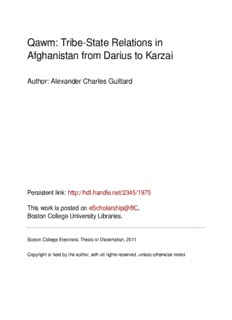
Qawm: Tribe-State Relations in Afghanistan from Darius to Karzai PDF
Preview Qawm: Tribe-State Relations in Afghanistan from Darius to Karzai
Qawm: Tribe-State Relations in Afghanistan from Darius to Karzai Author: Alexander Charles Guittard Persistent link: http://hdl.handle.net/2345/1975 This work is posted on eScholarship@BC, Boston College University Libraries. Boston College Electronic Thesis or Dissertation, 2011 Copyright is held by the author, with all rights reserved, unless otherwise noted. BOSTON COLLEGE QAWM: TRIBE-STATE RELATIONS IN AFGHANISTAN FROM DARIUS TO KARZAI A Senior Thesis Submitted to The College of Arts and Sciences Islamic Civilizations and Societies Program By ALEXANDER GUITTARD 11 May 2011 © ALEXANDER CHARLES GUITTARD 2011 “All politics is local” Thomas Phillip “Tip” O’Neill, ’36 Table of Contents List of Figures iii Acknowledgements iv Maps v 1 Questions in Kabul: An Introduction to the Political Geography of Afghanistan 1 2 The State-Society Balance of Power: Theoretical Approaches to Tribe-State Relations in Afghanistan 10 3 Foreign Invaders and Tribal Confederacies: Tribe-State Relations from Prehistory to the Nineteenth Century 21 4 “A beautiful monument without a foundation”: State Building in Afghanistan from 1880 to 1978 45 5 Invasion, Civil War, and Extremism: The Collapse of Central Power in Afghanistan from 1978 to 2001 73 Tribal Democracy: Contemporary Developments and a New Approach to Governance 102 Glossary 118 Bibliography 123 ii List of Figures Provinces of Afghanistan v Map of Nuristan vi Map of Panjsher vii Macro Distribution of Ethnicities of Afghanistan 4 Strong Societies and Weak States 16 The Durrani Dynasty (1747-1973) 39 Fusion and Fission in Modern Afghanistan 104 Estimates of Taliban Strength (2002-2006) 113 iii Acknowledgements This thesis is the product of almost two years of research, interviews, and drafts compiled in the midst of completing my undergraduate coursework and Army officer training. Though the errors are mine alone, this work could not have been completed without the friendship, support and council of many. My academic advisor, Dr. Ali Banuazizi, provided invaluable guidance and motivation throughout my research and writing. Without his assistance, this thesis would not have been completed. Dr. Kathleen Bailey similarly offered important direction and editorial advice that was essential to the completion of this work. My research trips to Afghanistan, which were supported financially by Boston College, owed their success to the hardworking and professional staff of the American Institute of Afghanistan Studies in Kabul. Dr. Omar Sharifi provided insight and introductions, set up interviews, and made his staff, Zafar, Rouallah, and Wali, available to support my research. Whether by providing a letter of introduction to a government official or guiding me through the book bazaar, I would not have made it far from my hotel without the help of the AIAS in Kabul. The interviews and primary document research conducted for this thesis could not have been completed without the patient and skilled language instruction of Dr. Franck Salameh, Dr. Sassan Tabatabai, Dr. Atef Ghrobrial, and Dr. Louissa Abdelghany. My theoretical approach to tribe-state relations was developed during research with Dr. Robert Ross, Boston College’s resident realist. Dr. Donald Hafner, Dr. Kenji Hayo, Dr. Marc Landy, Dr. Hiroshi Nakazato, and Dr. David DiPasquale were also mentors to whom I owe the development of my analytical and research skills. My superior officers also contributed to the completion of this thesis by allowing me to lighten my workload over the past semester. Some were more helpful than others, but I am grateful for the consideration I received. Most importantly, my family and close friends provided me with much needed encouragement and support throughout this project. This thesis, and indeed my entire education, would not have been completed without the support of my family. They tolerated my extended trips overseas and weekends in my office and did not object when I commandeered the dining room table because my desk was too small. My girlfriend, Lisette Garcia, was a constant source of motivation and support, bringing me late-night dinners and assisting with the editing and proof reading of the final drafts. Finally, this thesis was completed in spite of the best attempts of my roommates and close friends, all of whom engaged in a concerted effort to distract me from this project by their constant invitations to carouse around Cleveland Circle. iv Provinces of Afghanistan 1. Herat 18. Kunduz 2. Farah 19. Baghlan 3. Nimruz 20. Parwan 4. Badghis 21. Wardak 5. Faryab 22. Kabul 6. Ghor 23. Logar 7. Helmand 24. Paktia 8. Jowzjan 25. Paktika 9. Sar-e Pol 26. Khost 10. Daykundi 27. Takhar 11. Oruzgan 28. Panjshir 12. Qandahar 29. Kapisa 13. Balkh 30. Badakhshan 14. Samangan 31. Nuristan 15. Bamyan 32. Laghman 16. Ghazni 33. Nangarhar 17. Zabul 34. Kunar v e c n i v o r P n a t s i r u N vi e c n i v o r P r e h s j n a P vii
Description: